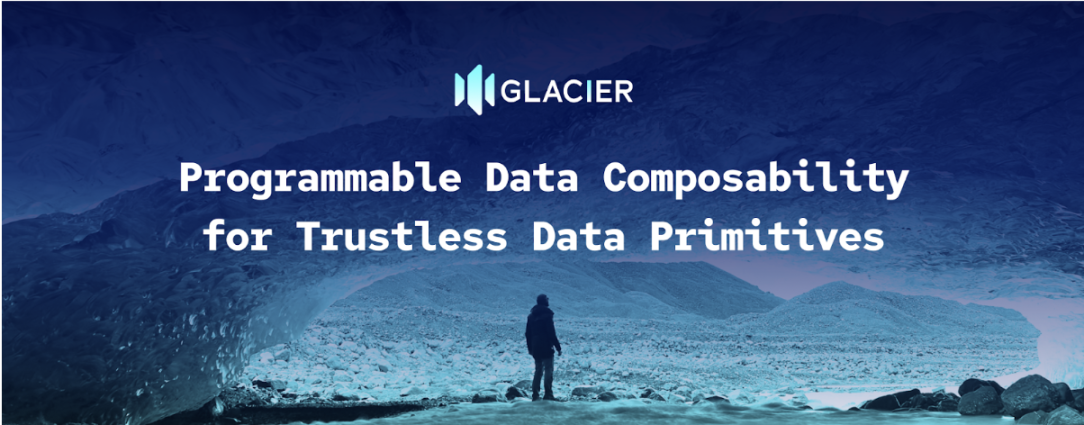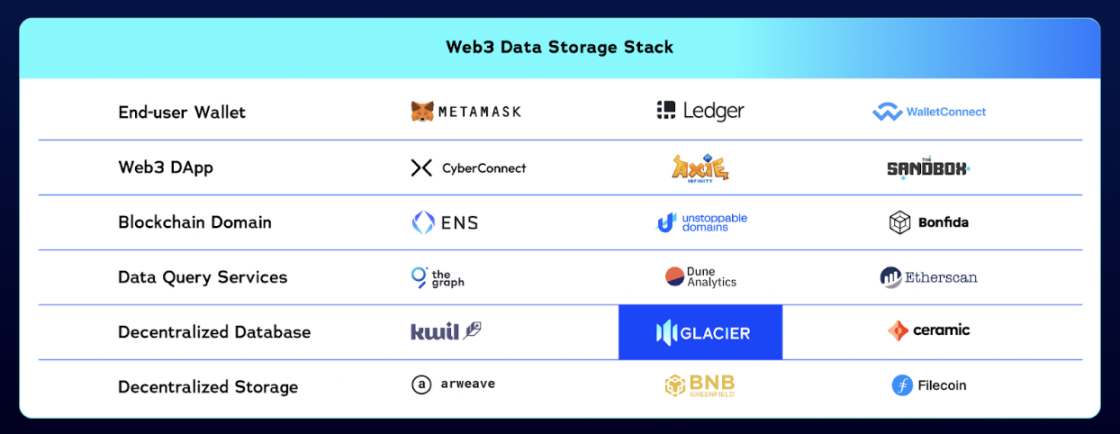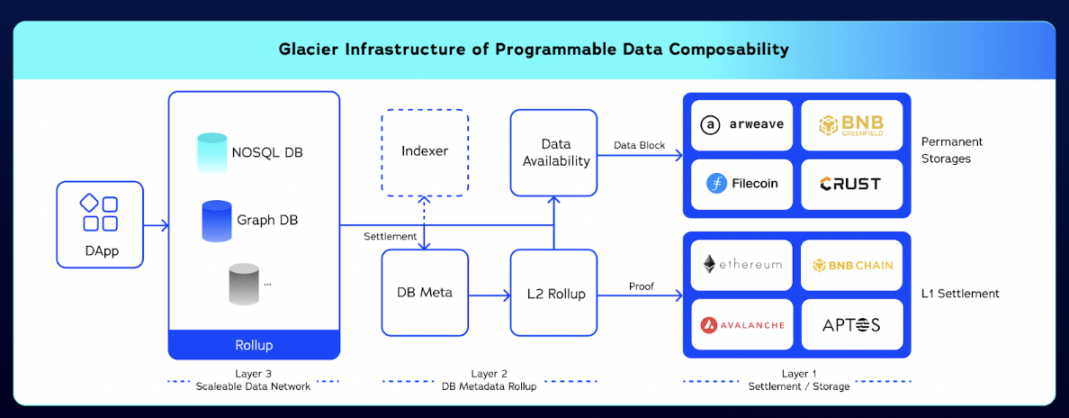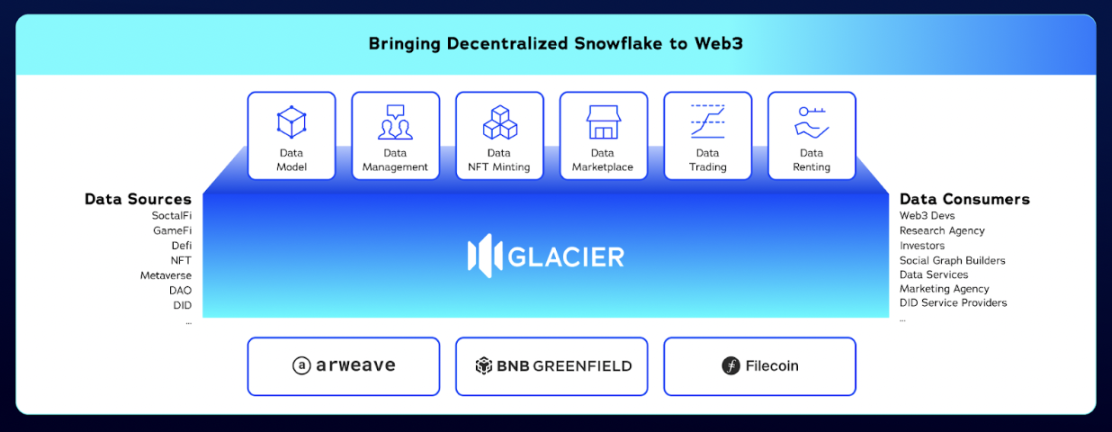The decentralized database is an important missing component of Web3, with enormous transformative potential in the future.
By: Glacier Network
Throughout history, data has been an important cornerstone of human civilization. In the age of the internet, with the explosive growth of information, the demand for structured data management has become urgent. In the 1960s, the human internet transitioned from the "no-database era" to the "database era," which promoted the vigorous development of the internet economy over the past 50 years.
Under the trend of Web3.0, Dapp applications are deepening rapidly, and data types are becoming increasingly diverse. The storage and management of data on smart contracts are exceptionally expensive, driving the demand for decentralized data management. However, the current track faces relatively blank technological barriers, and decentralized databases have long been in need.
The emergence of Glacier Network has created a composable, modular, and scalable Layer2 data-driven network for large-scale decentralized applications, and has promoted the creation of trustless data primitives for decentralized applications (Dapps) based on decentralized databases (DDB). Recently, Glacier announced the completion of a $2.9 million seed round of financing, with participation from Foresight X, UOB Venture Management, Signum Capital, Cogitent Ventures, and Gate Labs. It has also received grants and incubation support from multiple projects such as Arweave's ecosystem PermaDao, Boundless Hackathon Stanford, Aptos Grant Dao, and ForesightX Accelarator.
Leading VCs are entering the decentralized database field one after another. What exactly is the attraction?

Decentralized Database—An Overlooked Crucial Component of the Web3 Data Stack
At the end of 2022, Messari proposed the concept of "Decentralized Physical Infrastructure Network" (DePIN), considering it as "one of the most important tracks for crypto investment in the next decade." According to CoinGecko, the market value of this field has reached $5.2 billion.
In the infrastructure field, decentralized storage has always been the most eye-catching narrative track. Arthur Hayes recently also elaborated on the value of decentralized data stack in "Double Happiness." More and more Dapps are deploying decentralized storage, such as Arweave, Filecoin, and BNB Greenfield, leading the development of this field.
However, having only the "storage layer" is far from enough. Because the main value of the storage layer is permanent preservation, while high-frequency queries and structured management require "decentralized databases" to achieve. This is one of the pain points in the current data track.
The second pain point is that most Dapps are still using centralized cloud services. We know that centralized networks have single-point risks and are easily subject to review and variability when facing pressure such as policies, hardware failures, third-party attacks, etc. If the metadata assets in NFT/GameFi disappear, they become empty containers with no value.
The third pain point is the complex ecosystem of multiple chains and multiple storages, which makes the data act independently, forming isolated islands. Each technology has its own framework, protocol, and even language, making scalability and application popularization extremely difficult. Compared to a single-performance database, a "composable" and "programmable" solution is urgently needed.

Glacier—Building a "Modular" Layer 2 Data Network
Glacier combines L2 Rollup solutions to create a programmable and composable multi-chain data network, allowing developers to freely use NoSQL GlacierDB to manage data in Arweave, Filecoin, and BNB Greenfield.
"Modularity" and "composability" are the unique advantages of Glacier's decentralized database.
Glacier has surpassed the existence of a "database" and has become a composable "middleware" that supports the needs of users in multiple chains, multiple storages, and multiple ecosystems. It allows developers of various public chains to use the underlying storage they want without wasting time on redundant development work in the middleware.
The basic design principle is as follows: the application of Rollup technology will produce two types of data, Block Proof and Block Data. Block Proof is responsible for writing to the Layer1 public chain layer, and Block Data will be permanently stored in the storage layer. This technological design can effectively prevent fraud, reconstruct historical data, and significantly improve the operational efficiency and security of the database.

GlacierDB Empowers Applications—Unlocking the New Potential of Web3
Empowering Web3 applications is not a choice, but a mission.
1. "High Performance"
GlacierDB is a NoSQL non-relational database, and its KV key-value is more in line with the Ethereum model, supporting rich data types, flexibility, agility, and scalability. GlacierDB supports Key-value, Document, Columnar, and Graph storage, perfectly covering the various data needs of Web3, making it the best partner for Web3.
At the same time, through a professional technical stack architecture, including DB engine, Sharding, Rollup Sequencer, and Indexer, among other core components, Glacier has built a dynamically scalable high-performance decentralized database.
2. "Low Cost"
Helping developers reduce costs for product sustainability is crucial. In Glacier, through batch processing operations such as Bundle and Batch, developers can reduce storage gas costs by up to 90% compared to direct interaction with the storage layer.
3. "Low Threshold"
Glacier provides a MongoDB-like API, allowing even Web2 developers to quickly get started and deploy databases in one minute through the SDK. Lowering the threshold for developers is not just a strategy, but also a philosophy that can attract a wider range of users and enhance competitiveness.
4. "Data Model"
Data modeling is the most core and valuable part of the entire data flow. Glacier can effectively solve the Data Model structure problem of application data, especially for complex ecosystem data structures (such as SocialFi/NFT/Gamefi), empowering applications by abstracting massive application data and building Data Models.
"Permissionless" + "Trustless" Value Imagination Space

Decentralized databases are not just boring CRUD operations. The "Permissionless" nature of GlacierDB endows the concept of individual digital sovereignty and also solves the age-old problem of "Scalability."
Decentralized databases excel at managing high-frequency hot data for large-scale applications, such as SocialFi, GameFi, NFT Metadata, Dao voting data, DEX order books, and the complex data types of various Dapps.
1. "Social SocialFi"
Decentralized databases manage a large amount of redundant data in social protocols, generate social graphs, break down the barriers of social information across different platforms, and return social information to users, restoring things to their original state. They also have anti-censorship capabilities, empowering decentralization.
2. "Gaming"
There is currently an impossible triangle in blockchain gaming—playability, decentralization, and ease of use. Decentralized databases may be the key to breaking this deadlock. Game assets and player data are preserved in a decentralized manner, allowing players to experience the fun of the game while enjoying the wealth and freedom brought by blockchain.
3. "NFT Financialization"
There are still unexpected centralized operations behind NFTs, such as FTX using Web2 API to host NFT data, and currently, this NFT metadata has been damaged. The decentralized nature of NFTs not only guarantees economic value but also allows for real-time tracking and updating of metadata. When you buy an NFT, it will be a good habit to browse its metadata management method.
4. "AI Machine Learning"
As funds pour into the field of artificial intelligence, the market will be more optimistic about the decentralized storage track. Without data, artificial intelligence cannot learn. In the machine learning environment, the combination of decentralized vector databases and zk multi-party secure computation will enhance security, protect data privacy, and bring AI into the Web3 world.
As of now, there are over 50,000 databases created on Glacier, with over 260,000 on-chain CRUD operations. As stated in Messari's report "Decentralized Databases: The Missing Piece of Web3," decentralized databases are an important missing component of Web3 and have enormous transformative potential in the future.
免责声明:本文章仅代表作者个人观点,不代表本平台的立场和观点。本文章仅供信息分享,不构成对任何人的任何投资建议。用户与作者之间的任何争议,与本平台无关。如网页中刊载的文章或图片涉及侵权,请提供相关的权利证明和身份证明发送邮件到support@aicoin.com,本平台相关工作人员将会进行核查。




